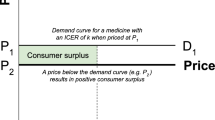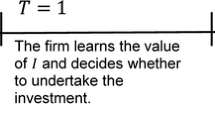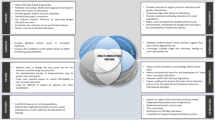Abstract
The rising cost of drugs is drawing scrutiny from many policymakers to the design of medical formularies. Formulary design is difficult because of the need to account for heterogeneity in patient characteristics, and the potential variation of cost-effectiveness of drugs across multiple conditions that they might be used to treat. In this article, we formulate the problem of selecting a medical formulary to minimize the cost of providing the drugs in the formulary, as well as the negative consequences to both patients and providers of the restrictions of the formulary. We model multiple drug categories and random variations in patient characteristics. We assume that patients are advised by physicians who are informed about the relative effectiveness of drugs that are available, and always make a rational choice to obtain the best expected outcome for their treatment. We derive insights into the structure of the optimal formulary under both certain and uncertain information about drugs’ effectiveness. Our model shows that widely used heuristics for drug selection that employ average or incremental cost-effectiveness ratios can perform very poorly. The model also shows that it is much more cost-effective for the payer to keep physicians informed about the relative effectiveness of drugs so that they can help patients to make customized choices, rather than to restrict the formulary for quality-control purposes.




Similar content being viewed by others
References
Agrawal, Y.P. (2005) Low dose naltrexone therapy in multiple sclerosis. Medical Hypotheses 64 (4): 721–724.
Cano, S.B. and Fujita, N.K. (1988) Formulary evaluation of third-generation cephalosporins using decision analysis. American Journal of Health-system Pharmacy 45 (3): 566.
Debreu, G. and Koopmans, T.C. (1982) Additively decomposed quasiconvex functions. Mathematical Programming 24 (1): 1–38.
Einarson, T.R., Arikian, S., Sweeney, S. and Doyle, J. (1995) A model to evaluate the cost-effectiveness of oral therapies in the management of patients with major depressive disorders. Clinical Therapeutics 17 (1): 136–153.
Foulke, G.E. and Siepler, J. (1990) Antiulcer therapy: An exercise in formulary management. Journal of Clinical Gastroenterology 12: S64.
Garber, A.M. and Phelps, C.E. (1997) Economic foundations of cost-effectiveness analysis. Journal of Health Economics 16 (1): 1–31.
Hearne, J. (2006) Prescription drug coverage under medicaid. Congressional Information Service. Library of Congress.
Herper, M. (2010) The world’s most expensive drugs. Forbes.com, accessed 4 July.
Jain, D.C., Vilcassim, N.J. and Chintagunta, P.K. (1994) A random-coefficients logit brand-choice model applied to panel data. Journal of Business & Economic Statistics 12 (3): 317–328.
Kök, A.G., Fisher, M.L. and Vaidyanathan, R. (2009) Assortment planning: Review of literature and industry practice. Retail Supply Chain Management 99–153.
Levy, R.A. and Cocks, D. (1999) Component management fails to save health care system costs. The case of restrictive formularies. National Pharmaceutical Council 56.
McFadden, D. (1973) Conditional logic analysis of qualitative choice behavior. Frontiers in Econometrics. Academic Press, pp. 105–142.
McFadden, D. (1978) Modelling the choice of residential location. Institute of Transportation Studies 673: 72–77.
Modesto-Lowe, V. and Van Kirk, J. (2002) Clinical uses of naltrexone: A review of the evidence. Experimental and Clinical Psychopharmacology 10 (3): 213.
Motheral, B.R. and Henderson, R. (2000) The effect of a closed formulary on prescription drug use and costs. Inquiry: A Journal of Medical Care Organization, Provision and Financing 36 (4): 481.
Olmstead, T. and Zeckhauser, R. (1999) The menu-setting problem and subsidized prices: Drug formulary illustration. Journal of Health Economics 18 (5): 523–550.
Soumerai, S.B., Ross-Degnan, D., Avorn, J., McLaughlin, T. and Choodnovskiy, I. (1991) Effects of medicaid drug-payment limits on admission to hospitals and nursing homes. The New England Journal of Medicine 325 (15): 1072.
Talluri, K.T. and Van Ryzin, G. (2005) The Theory and Practice of Revenue Management, Vol. 68. New York: Springer Verlag.
Tanielian, T. et al (2003) Impact of a uniform formulary on military health system prescribers: Baseline survey results. Technical report, RANO Corporation.
Van Ryzin, G. and Mahajan, S. (1999) On the relationship between inventory costs and variety benefits in retail assortments. Management Science 45 (11): 1496–1509.
Walkom, E., Robertson, J., Newby, D. and Pillay, T. (2006) The role of pharmacoeconomics in formulary decision-making. Formulary 41: 8.
Wang, Z., Salmon, J.W. and Walton, S.M. (2004) Cost-effectiveness analysis and the formulary decision-making process. Journal of Managed Care Pharmacy 10 (1): 48–59.
Author information
Authors and Affiliations
Corresponding author
Additional information
1joined the Industrial Engineering and Operations Research Department at Columbia in 2010. She received a Bachelor’s degree from University of Waterloo in Mathematics in 2002, and a PhD from Cornell University in Operations Research in 2007. Before coming to Columbia, she was a quantitative associate at Credit Suisse, and a quantitative researcher at Google. She is interested in a broad class of problems that arise Healthcare and Operations Management. These problems address decision making under uncertainty in highly dynamic environments. Her research focuses on developing tractable approximation algorithms for these problems and deriving insights into the optimal solutions. Her recent works involve a number of areas in Healthcare Policies and Healthcare Operations, including the scheduling of diagnostic and surgical resources in hospitals, the control of medical formularies, the pricing and designing of supply contracts for pharmaceuticals, and the management of public vaccine-stockpiles.
Appendix
Appendix
Proof of Theorem 1.For  , let
, let

Let  be an optimal solution of (Π) and let x* be the indicator-vector representation for
be an optimal solution of (Π) and let x* be the indicator-vector representation for  . That is,
. That is,  if
if  and
and  otherwise.
otherwise.
Fix a category p. Let  and
and  . Assume that there is l such that c
lp
⩽c
up
,
. Assume that there is l such that c
lp
⩽c
up
,  , but increasing
, but increasing  to 1 results in a suboptimal solution. Note that
to 1 results in a suboptimal solution. Note that

We claim that  . Assume otherwise. Let x° be obtained from x* by setting x
l
* to 1. Note that x° is a feasible solution for (Π). For each x(t)=x*+t(x°−x*), t∈[0, 1], it is clear that
. Assume otherwise. Let x° be obtained from x* by setting x
l
* to 1. Note that x° is a feasible solution for (Π). For each x(t)=x*+t(x°−x*), t∈[0, 1], it is clear that  . Therefore,
. Therefore,

which is a contradiction because we assumed that increasing  to 1 results in a suboptimal solution.
to 1 results in a suboptimal solution.
By inspecting the expression for  , we see that if
, we see that if  , then
, then  for all j such that c
pj
>c
pl
. Thus,
for all j such that c
pj
>c
pl
. Thus,  . Let
. Let  be obtained from x* by reducing x
u
* to 0. Note that
be obtained from x* by reducing x
u
* to 0. Note that  is a feasible solution for (Π). For each
is a feasible solution for (Π). For each  , t∈[0, 1], it is clear that
, t∈[0, 1], it is clear that  . Therefore,
. Therefore,

which is a contradiction because we assumed that x* is optimal. □
Proof of Corollary 2. If all drugs are specialized, then the problem (Π) separates into P independent subproblems. For each p, the p-th subproblem can be stated as

where  is the set of drugs used by category p. By Corollary 1, the solution to (Π
p
) consists of some k
p
of the lowest-cost drugs in
is the set of drugs used by category p. By Corollary 1, the solution to (Π
p
) consists of some k
p
of the lowest-cost drugs in  . Therefore, k
p
can be found using a linear search of at most
. Therefore, k
p
can be found using a linear search of at most  steps.
steps.
The total number of search steps performed over all patient categories is  □
□
Proof of Theorem 2. Let  be an optimal formulary. Let l be a bargain drug and assume that
be an optimal formulary. Let l be a bargain drug and assume that  is suboptimal. Let x be the indicator vector for
is suboptimal. Let x be the indicator vector for  . As in the proof of Theorem 1, we have
. As in the proof of Theorem 1, we have

As in the proof of Theorem 1, including l in  would not increase the objective. This contradicts our assumption. □
would not increase the objective. This contradicts our assumption. □
Proof of Theorem 3. Let  denote the set of all bargain drugs. By Theorem 2, we can assume without loss of generality that an optimal formulary has form
denote the set of all bargain drugs. By Theorem 2, we can assume without loss of generality that an optimal formulary has form  . Hence, the problem (Π) can be reduced to
. Hence, the problem (Π) can be reduced to

If all expensive drugs are specialized, then the problem (Π′) separates into P independent subproblems as in Corollary 1, each of which is solvable in linear time. That the solution to the problem (Π) consists of some k p of the lowest-cost drugs for each category p can be proved similarly to Corollary 1. □
Proof of Theorem 4. Let F(x) be as in (8). Let  be an optimal solution of (Π) and let x* be the indicator vector for
be an optimal solution of (Π) and let x* be the indicator vector for  . That is, x
j
*=1 if
. That is, x
j
*=1 if  and x
j
*=0 otherwise.
and x
j
*=0 otherwise.
Let u be any drug with in  . Assume that x
l
*=0, x
u
*=1, l dominates u, but increasing x
l
* to 1 results in a suboptimal solution. Note that
. Assume that x
l
*=0, x
u
*=1, l dominates u, but increasing x
l
* to 1 results in a suboptimal solution. Note that

As in the proof of Theorem 1,  . As l dominates u, this implies that
. As l dominates u, this implies that  . Therefore, as in the proof of Theorem 1, we have a contradiction. □
. Therefore, as in the proof of Theorem 1, we have a contradiction. □
Proof of Theorem 5. Let us compare the value of a selection  with that of the larger selection
with that of the larger selection  .
.
The selection  is better if and only if
is better if and only if

The inequality reduces to

It is easy to see that the right-hand side is non-negative. If  for each p then the left-hand side is less than or equal to 0, so that the inequality above holds. □
for each p then the left-hand side is less than or equal to 0, so that the inequality above holds. □
Proof of Theorem 6. Let us compare the value of a selection  with that of the larger selection
with that of the larger selection  . Similar to the proof of Theorem 5, the selection
. Similar to the proof of Theorem 5, the selection  is better if and only if
is better if and only if

It is easy to see that the right-hand side is positive. If b p is sufficiently high, then the above inequality holds. □
Proof of Theorem 7. Let  be an optimal formulary. Let F(x) be defined according to (8). Let x* be the indicator-vector representation for
be an optimal formulary. Let F(x) be defined according to (8). Let x* be the indicator-vector representation for  .
.
Fix a category p. Assume that there are more than one drug for p in  . Let l be the highest-cost drug among these. Then in particular, c
pl
>b
p
, or l cannot be a bargain drug. Recall from Theorem 1 that
. Let l be the highest-cost drug among these. Then in particular, c
pl
>b
p
, or l cannot be a bargain drug. Recall from Theorem 1 that

which is positive by the assumption of the theorem. Similar to the proof of Theorem 1, removing j from S results in a strictly better formulary, which is a contradiction. Hence, there can be at most one drug per category in the optimal formulary. The conclusion follows from Theorem 1. □
Proof of Proposition 1. Fix a category p. By Theorem 1,  is equal to {[1]p,[2]p, …, [k]p} for some k.
is equal to {[1]p,[2]p, …, [k]p} for some k.
We will first construct μ′ such that  From the definition of majorization, there is a l such that
From the definition of majorization, there is a l such that  where l ⩽ k and
where l ⩽ k and  Define μ′ by letting
Define μ′ by letting  for all i<l,
for all i<l,  , and μ′
pi
=0 otherwise. Then
, and μ′
pi
=0 otherwise. Then  .
.
We claim that  . Indeed, we can write
. Indeed, we can write  as
as

The inequality follows from the fact that  for each j=1, …, k and
for each j=1, …, k and  imply that
imply that  for each j=1, …, k.
for each j=1, …, k.
By the claim, we have  .
.
Next, let x* be the indicator-vector representation for  . We will abuse notation and use F(μ′, x*) to mean
. We will abuse notation and use F(μ′, x*) to mean  . Similar to the proof of Theorem 1, note that
. Similar to the proof of Theorem 1, note that  is equal to
is equal to

If  then decreasing
then decreasing  to 0 results in a better solution. Otherwise, increasing
to 0 results in a better solution. Otherwise, increasing  to
to  results in a better solution. In the former case, as μ and μ′ are the same in components [1] to [l − 1], we have
results in a better solution. In the former case, as μ and μ′ are the same in components [1] to [l − 1], we have  In the latter case, letting y* denote the modification of x*, we have by construction of y*,
In the latter case, letting y* denote the modification of x*, we have by construction of y*, 
Therefore,  □
□
Proof of Theorem 9. Note that the provisioning cost is unchanged with b for categories p ⩾ 2. For category 1, the expected cost is

We can write

which is concave in ν1j. By Jensen’s inequality, this cost is less than or equal to

with the difference increasing as b increases. Therefore, the provisioning cost of  decreases as b increases. □
decreases as b increases. □
Proof of Theorem 10. As in the proof of Theorem 9, the provisioning cost is unchanged with b for categories p ⩾ 2. For category 1, the expected cost is

We can write

which is convex in ν1j. By Jensen’s inequality, this cost is less than or equal to

with the difference increasing as b increases. Therefore, the provisioning cost of  increases as b increases. □
increases as b increases. □
Proof of Theorem 11. Note that

The conditional expectation  is less than or equal to
is less than or equal to  by Jensen’s inequality, with the difference increasing as b increases.
by Jensen’s inequality, with the difference increasing as b increases.
Rights and permissions
About this article
Cite this article
Truong, VA. Optimal selection of medical formularies. J Revenue Pricing Manag 13, 113–132 (2014). https://doi.org/10.1057/rpm.2013.15
Received:
Revised:
Published:
Issue Date:
DOI: https://doi.org/10.1057/rpm.2013.15




